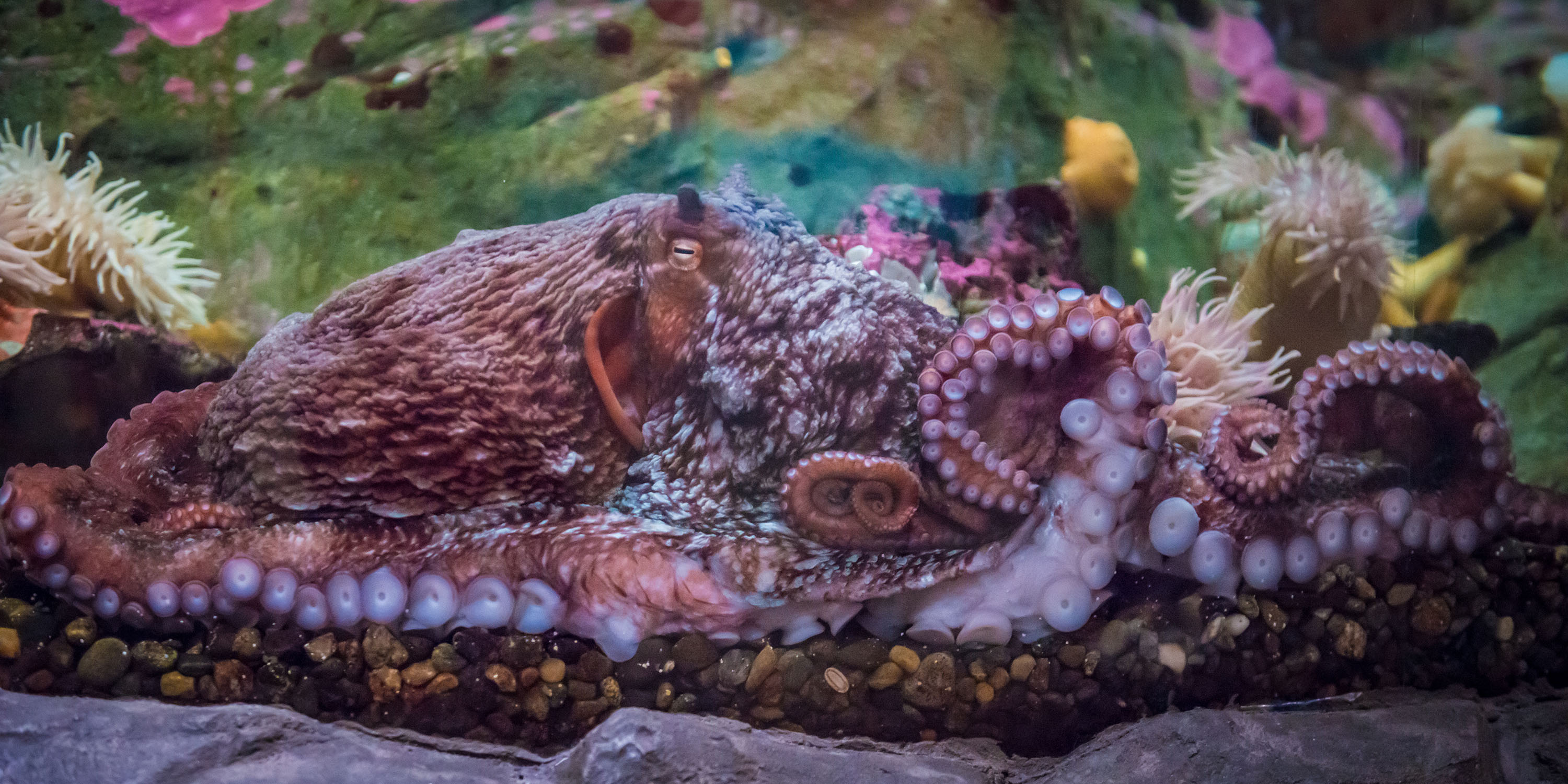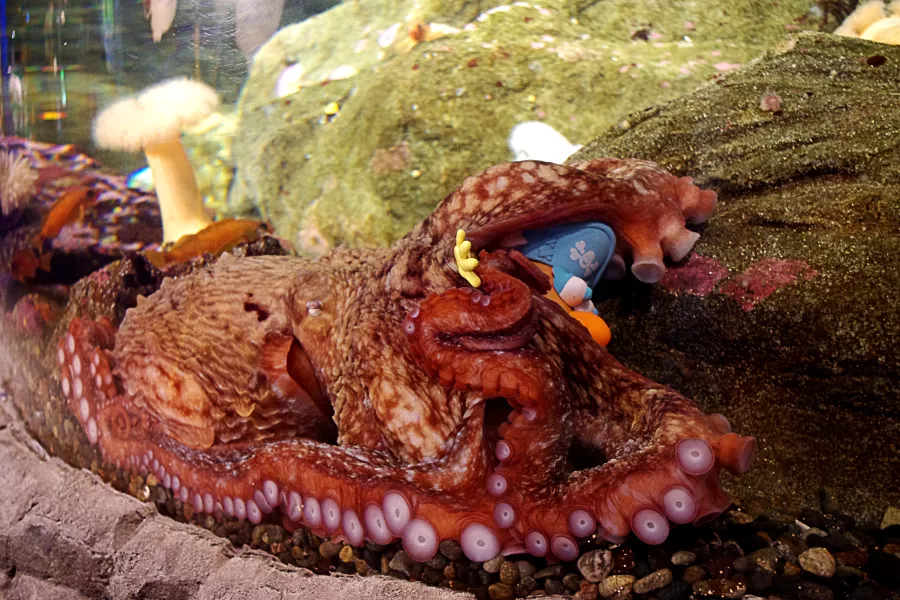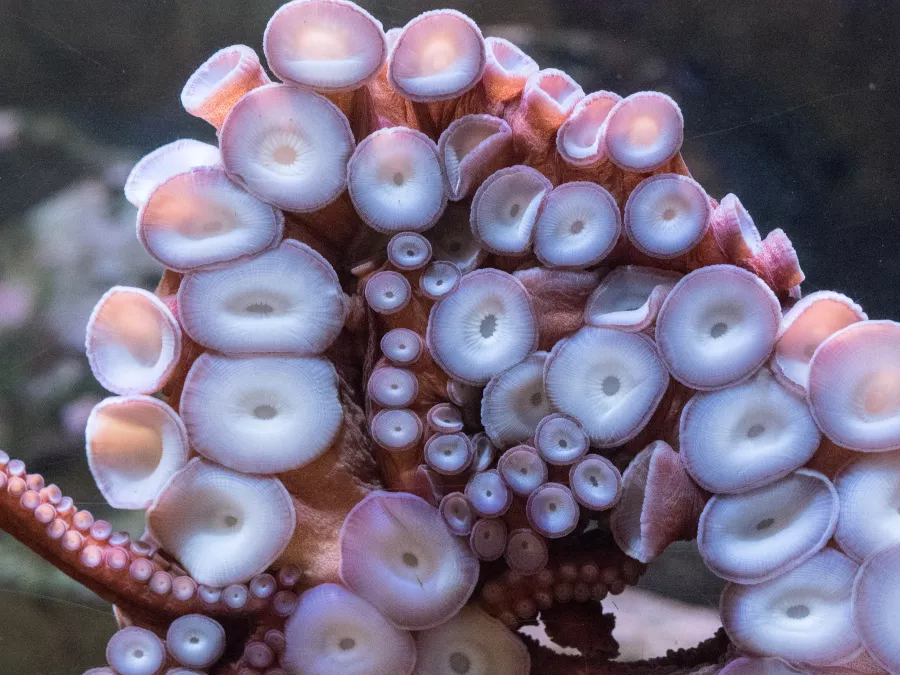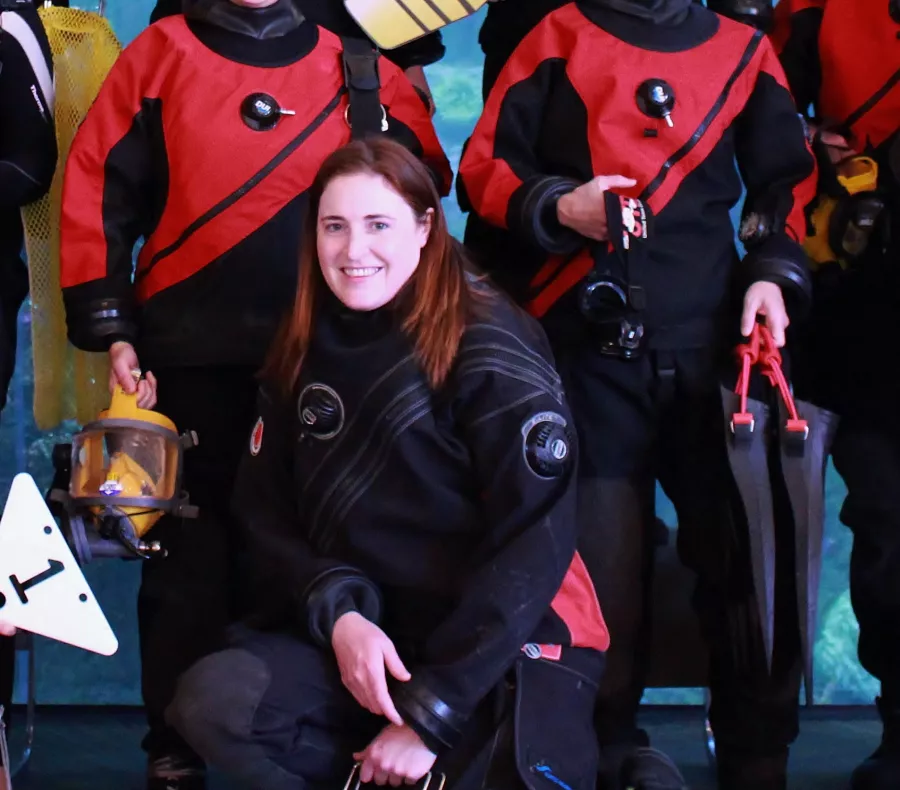Ink Jet is at rest, her skin pinkish and bumpy, tentacles pressed against the acrylic walls of her aquarium. Then she pokes her head up.
Kathryn Kegel, ’05, is looking back. “I just like it when they bop their little heads up and look at you,” Kegel says.
In a dimly lit chamber of the Seattle Aquarium, with a steady stream of masked adults and children strolling by, Ink Jet recognizes Kegel instantly, and watches her every move.
Kegel, who graduated from Western in 2005, is a senior aquarist at the Seattle Aquarium, and the main person looking after Ink Jet and Kraken, two members of one of the Northwest’s most amazing species: the Giant Pacific Octopus.
Apart from the pair of keen-sighted though color-blind eyes following Kegel, the body plan of an octopus is nothing like ours. They have three hearts and eight arms, each lined with about 200 suckers. Each of those suckers is covered with receptors for touch and taste. (Imagine experiencing the world with your arms and legs replaced by giant tongues.) Their blood is blue.
Octopuses change the color and texture of their skins in seconds for camouflage, or with mood.
Octopuses may look liquid, with their undulating movements and their ability to squeeze through tiny openings, but if you pick them up, they’re all muscle, with a fearsome grip. Circular “octopus hickies” are a hazard of Kegel’s work.
As Ink Jet settles into a new spot in her aquarium, her arms curl, uncurl and sway in several directions at once. It’s more like watching a flock of birds than watching an individual animal, even a boneless one, like a slug.
Octopuses have a central brain, and each of their arms has its own brain-like cluster of neurons that controls the arm’s movement. That’s right: each arm has a mind of its own.
But what really astounds people is octopus intelligence. Evidence of their ability to learn and solve problems has upended many accepted notions about where intelligence comes from. Unlike other intelligent species, such as humans and parrots, octopuses aren’t long-lived. Five years is the maximum lifespan for a Giant Pacific Octopus.
They don’t interact socially or nurture their young.
In fact, everything we know about Giant Pacific Octopuses indicates that they live almost all their lives alone, and come together only to mate.
“They’ll check you out”
When Giant Pacific Octopuses hatch, they are the size of grains of rice. A current of water from their mother’s siphon propels them out of the den, and they rise to the surface of the water, and begin a life as plankton, hunting and devouring animals smaller than themselves, until they are big enough to make a life on the sea bottom.
The smallest Giant Pacific Octopus that Kegel has ever found on the sea bottom weighed five grams: as much as a nickel. Once on the sea bottom, they avoid other octopuses. They find a territory where they make a den between rocks, and go out and forage for food.
It means they are constantly exploring the area around them. When scuba divers make their way into their underwater lairs, they’ll watch, or even come up to them and investigate.
“They’re very curious. They’ll check you out,” Kegel says.
At about a year old and weighing two pounds, Ink Jet is a capable adult. Kegel says that, if anything, she finds younger octopuses more curious than older ones.
Kraken, the Seattle Aquarium’s other Giant Pacific Octopus, resides in an aquarium in the big room with the artificial tide pools. The top of the aquarium is lined with synthetic turf, which octopuses find unpleasant to grip. A quick search on YouTube will show you why the turf is there: in 2015 one of Kraken’s predecessors, an octopus named Ink, pulled his body up over the edge of the tank, as a crowd of excited tourists recorded the incident on their phones.
Not that Kraken, who weighs 40 pounds and is somewhere between 1 and 2 years old, shows much inclination for that kind of stunt. He’s “pretty mellow,” Kegel says.
“I’m more than happy to have a mellow octopus.”
Individual octopuses have their own food preferences, and they’ll behave differently. Some will rearrange objects in their aquariums. Kraken leaves the space alone. And he’s content to keep to himself as Kegel cleans his aquarium. Some of his predecessors have been inclined to steal Kegel’s brushes.
Engaging their intelligence is a big part of looking after these animals.
Sometimes it’s as simple as rearranging the rocks in their aquarium. Octopuses like to stimulate their senses, exploring new shapes and textures.
Kegel has never met an octopus that didn’t enjoy having a shower via the spray attachment of a hose. She shows me a video. The octopus has stretched his tentacles across the surface of the water, its suckers directed toward the drops coming from the hose. Every so often a squirt comes up between the tentacles.
“He’s squirting me back.”
They also relish taking things apart. Put a Mr. Potato Head into the aquarium, and an octopus will yank out the hat, arms, eyes, nose, lips and feet and strew them around.
Tidiness is not an octopus habit.
When diving, Kegel can spot an octopus den by the litter of shells and bones discarded around the entrance.
“They keep the house very clean and the front yard very dirty.”
Among the items Kegel has introduced to octopus aquariums: Duplo blocks, hamster balls and various dog toys. The octopuses at Seattle Aquarium do an increasingly complex series of challenges to get food items out of containers.
How an octopus approaches a puzzle, and how long it takes to solve it, depends on the individual. But all of them will learn and remember the puzzles they get. If it takes octopus 10 minutes to unscrew a jar for the first time, it will be open within five minutes the second time.
Ink Jet and Kraken can unscrew jars to get at food. So far, Kegel hasn’t introduced them to child-proof lids, but several of their predecessors became adept at opening those. At times what octopuses learn to manipulate is the people around them.
Kegel has seen an octopus distract people by grabbing at them, while another arm reaches out of the aquarium to raid a nearby food bowl.
Behold the slime star
Ever since she can remember, Kegel has been fascinated by marine life in general and invertebrates in particular. She grew up in Aberdeen and her family took frequent trips to the Pacific Ocean at Westport, Ocean Shores, and near her grandparents’ home in Santa Cruz, California.
She was always entranced by invertebrates, and the sheer variety of forms they can take. She loved messing about in tide pools.
She started at Western in 2000, and began in biology and then switched over to Huxley College of the Environment for a B.S. in environmental science. Her favorite class: a course on marine invertebrates, taught by Brian Bingham at Western Washington University’s Shannon Point Marine Center in Anacortes.
“We would go out and collect animals and bring them back to Shannon Point, sit with a notebook and draw them,” Kegel says.
It was there that she first learned about what is now her favorite animal, the slime star. It’s a chubby-looking sea star with five stubby arms, that comes in gray, brown or orange and has a spectacular ability. When threatened, it will produce slime. Lots of it. A slime star that can fit in a saucer can squirt out a cantaloupe-sized glob of slime.
“It just produces this big wad of snot, and it’s so cool,” she says.
WWU helped her get an internship at the Seattle Aquarium in 2005. She stayed on as a temp in 2006 and was hired full time in 2007, and she loves her work.
“I fell in love with the diversity of the job and never left.”
Her focus within the aquarium is the care, feeding and husbandry of animals on the cold-water side, particularly invertebrates.
Along with working with octopuses and other animals, the job involves designing exhibits, plumbing and scuba diving for maintenance of the exhibits.
She’s part of the team that goes to Neah Bay and parts of Puget Sound to collect animals. (She always makes sure that the Aquarium has a slime star on display.) She lives in West Seattle, and scuba dives in nearby waters as a hobby.
She appreciates the affection the local dive community has for octopuses. After a diver legally hunted and killed an 80-pound octopus off West Seattle in 2012, local divers were so outraged that they successfully lobbied the state to designate 10 sites as sanctuaries, where octopus hunting is illegal.
While they are at the aquarium, Giant Pacific Octopuses eat, grow, and learn constantly. But at some point, their behavior will shift, and they’ll become less interested in feeding.
That means they are nearly ready to mate, and it’s time for Kegel and the aquarium staff to plan to return them to the area where they found them.
You can find videos of the Aquarium’s octopus releases on YouTube. Using a bucket perforated with holes, biologists gently lower the octopus into the water, and it swims out. Divers follow it for about 20 minutes, and then Kegel doesn’t know what happens next in the story. Biologists don’t have a way of tracking octopuses at the bottom of Puget Sound. You can’t put a radio tag on them, the way you could on a fish (or a murder hornet). And—sorry, conspiracy theorists —there’s no such thing as a tracker you could safely inject intravenously.
So Kegel just has to hope that the octopuses go on to find mates. A male octopus will die soon after mating. A female octopus will retreat to a den, lay up to 74,000 eggs there, and stay in the den for seven months, keeping the eggs clean. She doesn’t eat and her skin turns a ghostly gray. She dies after the hatch. The beginning of the next generation is the end of the mother.
Compared to our messy existence, ruled by social pressures and gravity, the life and experience of an octopus is alien. And yet, they have the capacity to connect with people.
Kegel sees that every time one bops up its head at her approach.
“You get the impression you’re looking at the octopus, and it’s looking back at you.”



